University Marketing Report: Data Analysis in the Marketing Sector
VerifiedAdded on 2022/11/10
|9
|2131
|108
Report
AI Summary
This report delves into the critical role of data analysis within the marketing sector. It begins by outlining the significance of information and data in the industry, emphasizing how data shapes content marketing strategies and improves client engagement. The report then differentiates between first, second, and third-party data, detailing their collection methods and applications. It explores the operational processes where data is utilized, such as developing targeted marketing strategies and conducting predictive analysis. The report also examines data capture and storage methods, including the use of primary keys and various database types. Furthermore, it highlights the benefits of data-driven decision-making, such as improved identification of trends and reduced biases. Finally, the report discusses the importance of primary and secondary market research in conjunction with MIS and database systems to enhance insights, providing a comprehensive overview of data's impact on marketing strategies and business outcomes.
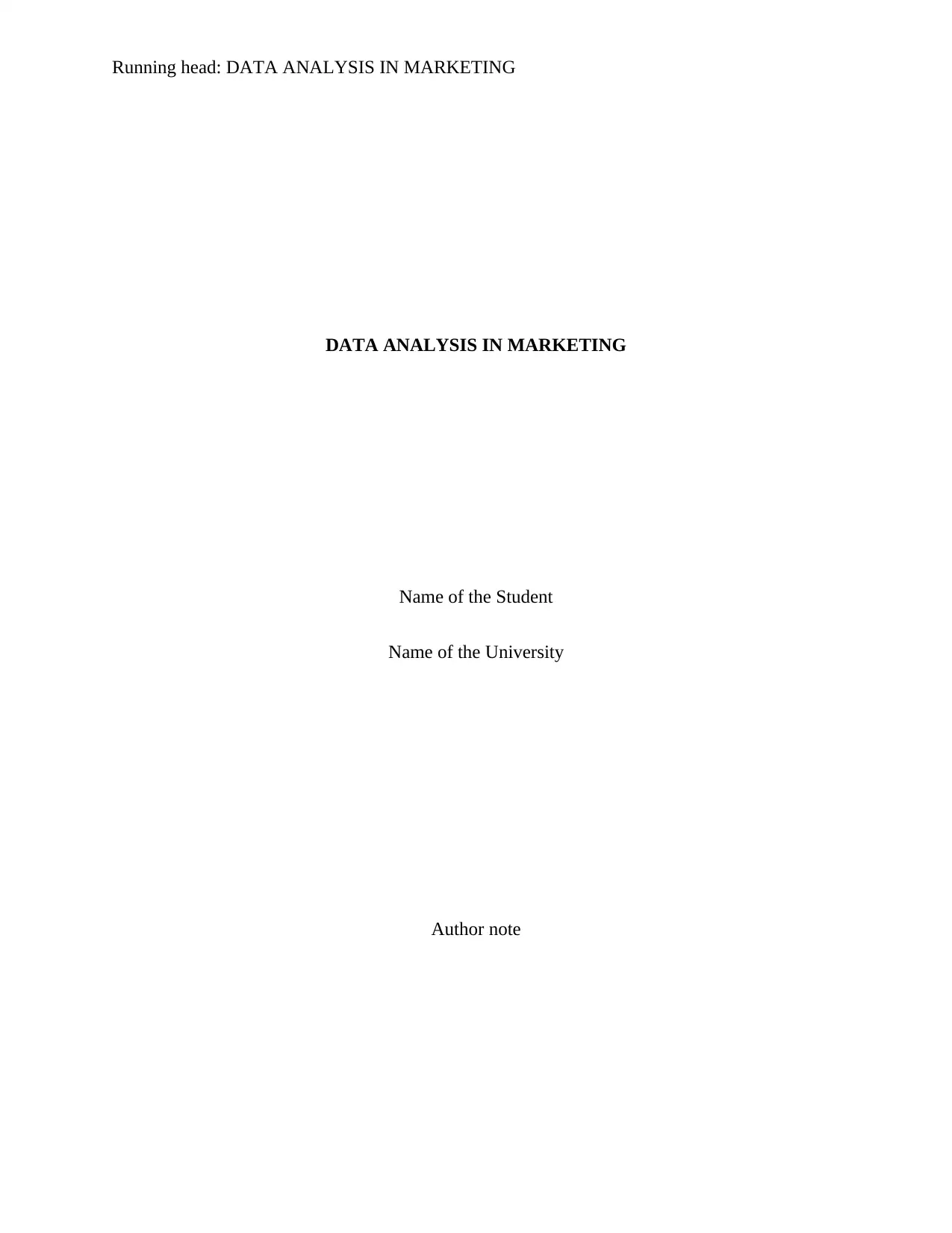
Running head: DATA ANALYSIS IN MARKETING
DATA ANALYSIS IN MARKETING
Name of the Student
Name of the University
Author note
DATA ANALYSIS IN MARKETING
Name of the Student
Name of the University
Author note
Paraphrase This Document
Need a fresh take? Get an instant paraphrase of this document with our AI Paraphraser
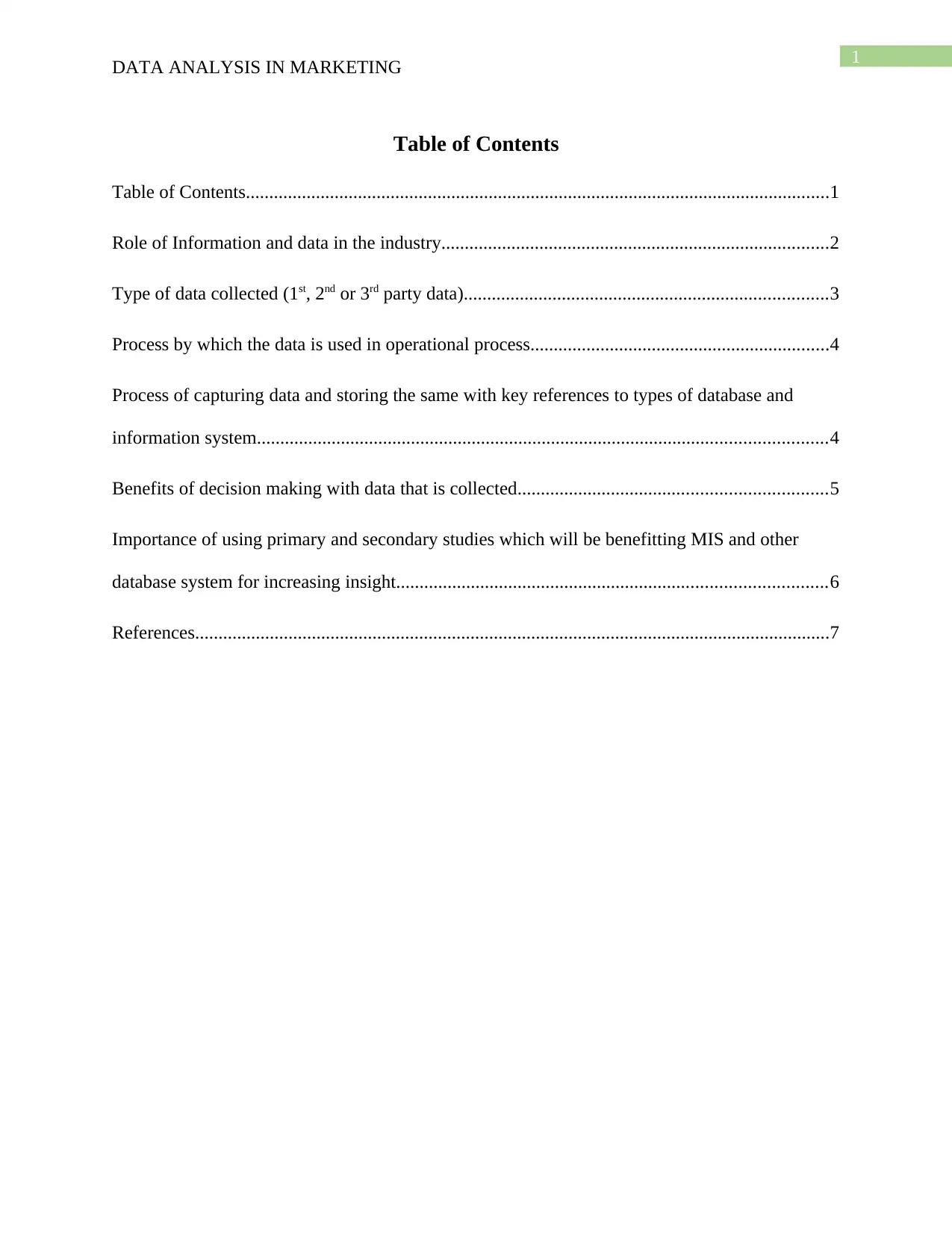
1
DATA ANALYSIS IN MARKETING
Table of Contents
Table of Contents.............................................................................................................................1
Role of Information and data in the industry...................................................................................2
Type of data collected (1st, 2nd or 3rd party data)..............................................................................3
Process by which the data is used in operational process................................................................4
Process of capturing data and storing the same with key references to types of database and
information system..........................................................................................................................4
Benefits of decision making with data that is collected..................................................................5
Importance of using primary and secondary studies which will be benefitting MIS and other
database system for increasing insight............................................................................................6
References........................................................................................................................................7
DATA ANALYSIS IN MARKETING
Table of Contents
Table of Contents.............................................................................................................................1
Role of Information and data in the industry...................................................................................2
Type of data collected (1st, 2nd or 3rd party data)..............................................................................3
Process by which the data is used in operational process................................................................4
Process of capturing data and storing the same with key references to types of database and
information system..........................................................................................................................4
Benefits of decision making with data that is collected..................................................................5
Importance of using primary and secondary studies which will be benefitting MIS and other
database system for increasing insight............................................................................................6
References........................................................................................................................................7
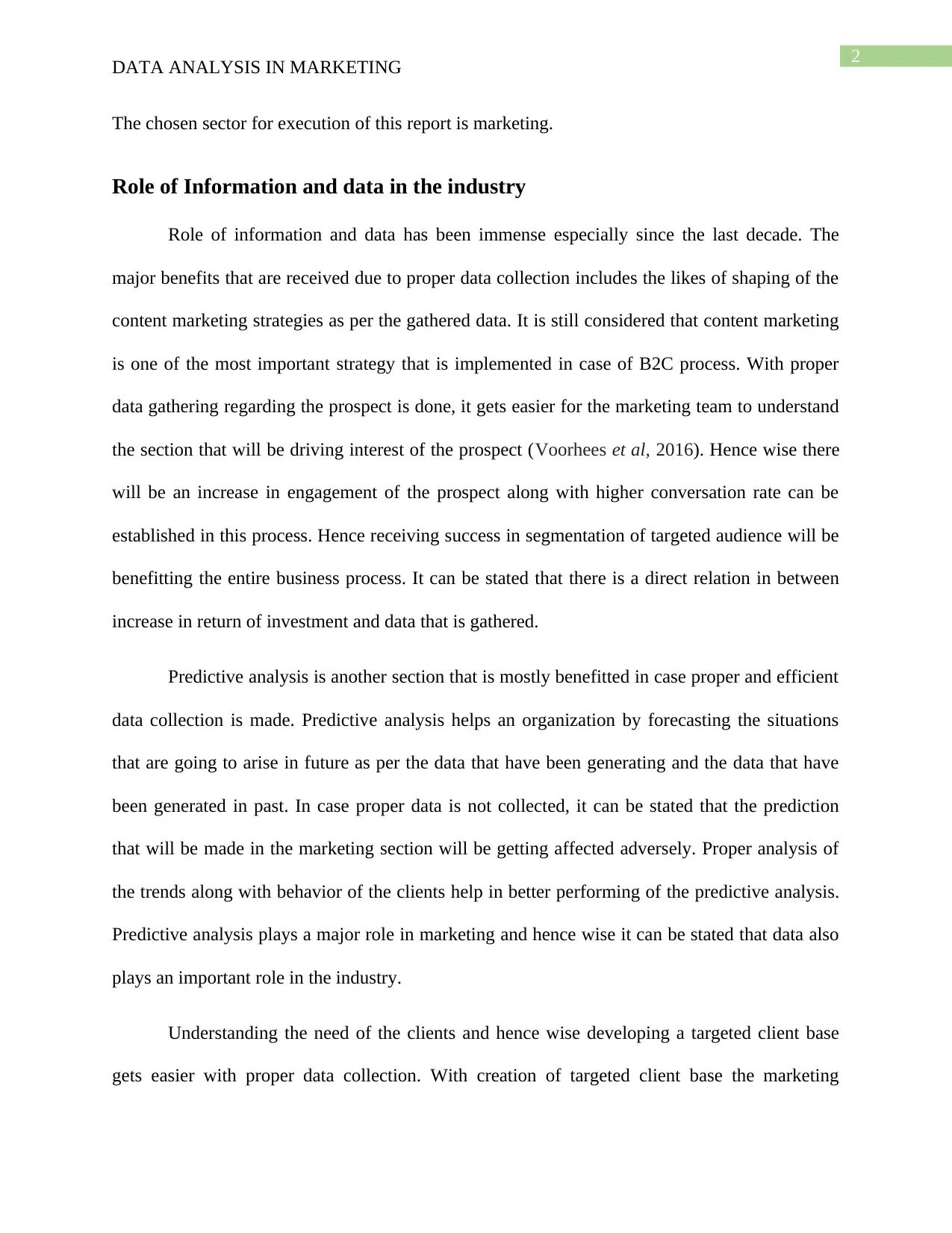
2
DATA ANALYSIS IN MARKETING
The chosen sector for execution of this report is marketing.
Role of Information and data in the industry
Role of information and data has been immense especially since the last decade. The
major benefits that are received due to proper data collection includes the likes of shaping of the
content marketing strategies as per the gathered data. It is still considered that content marketing
is one of the most important strategy that is implemented in case of B2C process. With proper
data gathering regarding the prospect is done, it gets easier for the marketing team to understand
the section that will be driving interest of the prospect (Voorhees et al, 2016). Hence wise there
will be an increase in engagement of the prospect along with higher conversation rate can be
established in this process. Hence receiving success in segmentation of targeted audience will be
benefitting the entire business process. It can be stated that there is a direct relation in between
increase in return of investment and data that is gathered.
Predictive analysis is another section that is mostly benefitted in case proper and efficient
data collection is made. Predictive analysis helps an organization by forecasting the situations
that are going to arise in future as per the data that have been generating and the data that have
been generated in past. In case proper data is not collected, it can be stated that the prediction
that will be made in the marketing section will be getting affected adversely. Proper analysis of
the trends along with behavior of the clients help in better performing of the predictive analysis.
Predictive analysis plays a major role in marketing and hence wise it can be stated that data also
plays an important role in the industry.
Understanding the need of the clients and hence wise developing a targeted client base
gets easier with proper data collection. With creation of targeted client base the marketing
DATA ANALYSIS IN MARKETING
The chosen sector for execution of this report is marketing.
Role of Information and data in the industry
Role of information and data has been immense especially since the last decade. The
major benefits that are received due to proper data collection includes the likes of shaping of the
content marketing strategies as per the gathered data. It is still considered that content marketing
is one of the most important strategy that is implemented in case of B2C process. With proper
data gathering regarding the prospect is done, it gets easier for the marketing team to understand
the section that will be driving interest of the prospect (Voorhees et al, 2016). Hence wise there
will be an increase in engagement of the prospect along with higher conversation rate can be
established in this process. Hence receiving success in segmentation of targeted audience will be
benefitting the entire business process. It can be stated that there is a direct relation in between
increase in return of investment and data that is gathered.
Predictive analysis is another section that is mostly benefitted in case proper and efficient
data collection is made. Predictive analysis helps an organization by forecasting the situations
that are going to arise in future as per the data that have been generating and the data that have
been generated in past. In case proper data is not collected, it can be stated that the prediction
that will be made in the marketing section will be getting affected adversely. Proper analysis of
the trends along with behavior of the clients help in better performing of the predictive analysis.
Predictive analysis plays a major role in marketing and hence wise it can be stated that data also
plays an important role in the industry.
Understanding the need of the clients and hence wise developing a targeted client base
gets easier with proper data collection. With creation of targeted client base the marketing
⊘ This is a preview!⊘
Do you want full access?
Subscribe today to unlock all pages.

Trusted by 1+ million students worldwide
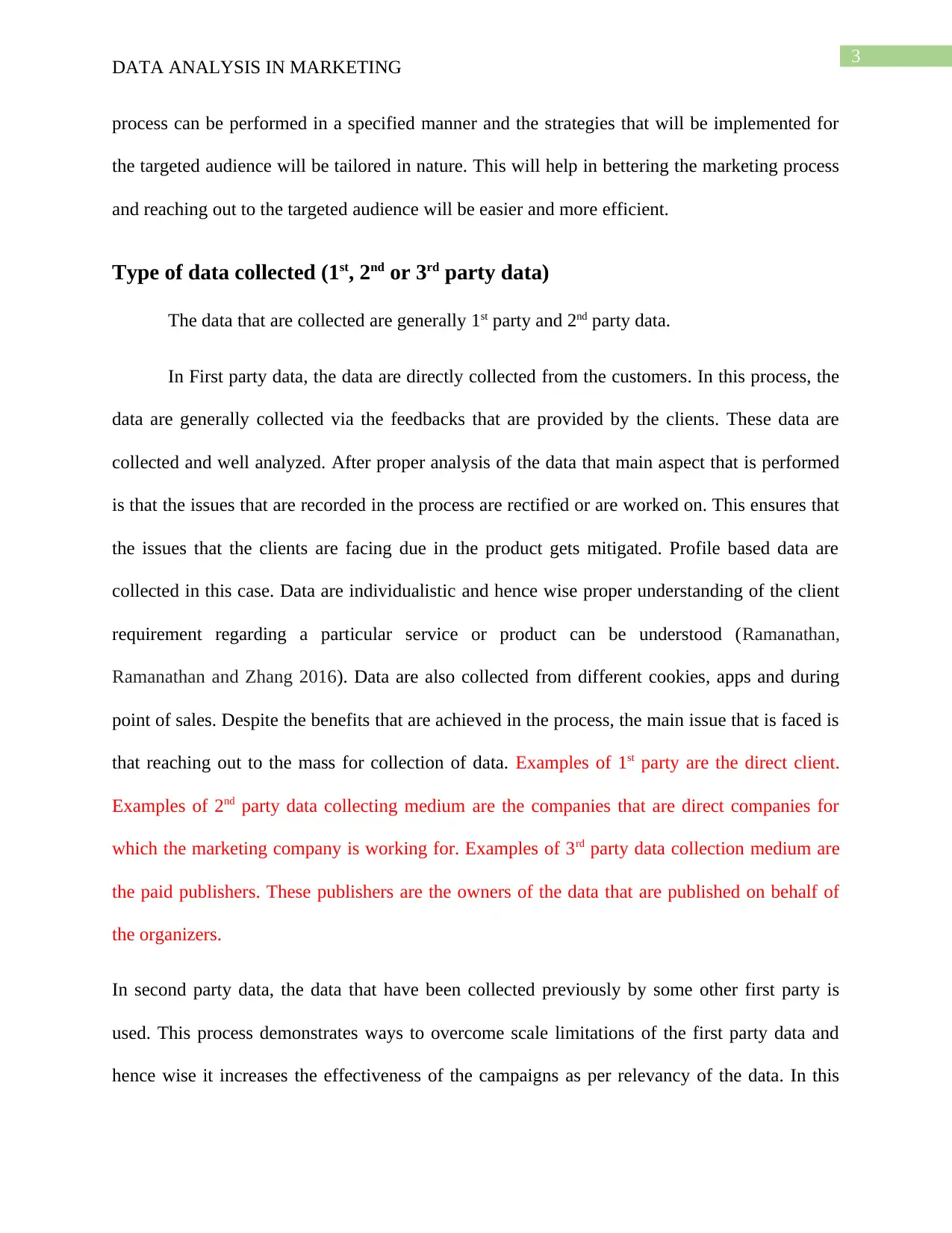
3
DATA ANALYSIS IN MARKETING
process can be performed in a specified manner and the strategies that will be implemented for
the targeted audience will be tailored in nature. This will help in bettering the marketing process
and reaching out to the targeted audience will be easier and more efficient.
Type of data collected (1st, 2nd or 3rd party data)
The data that are collected are generally 1st party and 2nd party data.
In First party data, the data are directly collected from the customers. In this process, the
data are generally collected via the feedbacks that are provided by the clients. These data are
collected and well analyzed. After proper analysis of the data that main aspect that is performed
is that the issues that are recorded in the process are rectified or are worked on. This ensures that
the issues that the clients are facing due in the product gets mitigated. Profile based data are
collected in this case. Data are individualistic and hence wise proper understanding of the client
requirement regarding a particular service or product can be understood (Ramanathan,
Ramanathan and Zhang 2016). Data are also collected from different cookies, apps and during
point of sales. Despite the benefits that are achieved in the process, the main issue that is faced is
that reaching out to the mass for collection of data. Examples of 1st party are the direct client.
Examples of 2nd party data collecting medium are the companies that are direct companies for
which the marketing company is working for. Examples of 3rd party data collection medium are
the paid publishers. These publishers are the owners of the data that are published on behalf of
the organizers.
In second party data, the data that have been collected previously by some other first party is
used. This process demonstrates ways to overcome scale limitations of the first party data and
hence wise it increases the effectiveness of the campaigns as per relevancy of the data. In this
DATA ANALYSIS IN MARKETING
process can be performed in a specified manner and the strategies that will be implemented for
the targeted audience will be tailored in nature. This will help in bettering the marketing process
and reaching out to the targeted audience will be easier and more efficient.
Type of data collected (1st, 2nd or 3rd party data)
The data that are collected are generally 1st party and 2nd party data.
In First party data, the data are directly collected from the customers. In this process, the
data are generally collected via the feedbacks that are provided by the clients. These data are
collected and well analyzed. After proper analysis of the data that main aspect that is performed
is that the issues that are recorded in the process are rectified or are worked on. This ensures that
the issues that the clients are facing due in the product gets mitigated. Profile based data are
collected in this case. Data are individualistic and hence wise proper understanding of the client
requirement regarding a particular service or product can be understood (Ramanathan,
Ramanathan and Zhang 2016). Data are also collected from different cookies, apps and during
point of sales. Despite the benefits that are achieved in the process, the main issue that is faced is
that reaching out to the mass for collection of data. Examples of 1st party are the direct client.
Examples of 2nd party data collecting medium are the companies that are direct companies for
which the marketing company is working for. Examples of 3rd party data collection medium are
the paid publishers. These publishers are the owners of the data that are published on behalf of
the organizers.
In second party data, the data that have been collected previously by some other first party is
used. This process demonstrates ways to overcome scale limitations of the first party data and
hence wise it increases the effectiveness of the campaigns as per relevancy of the data. In this
Paraphrase This Document
Need a fresh take? Get an instant paraphrase of this document with our AI Paraphraser
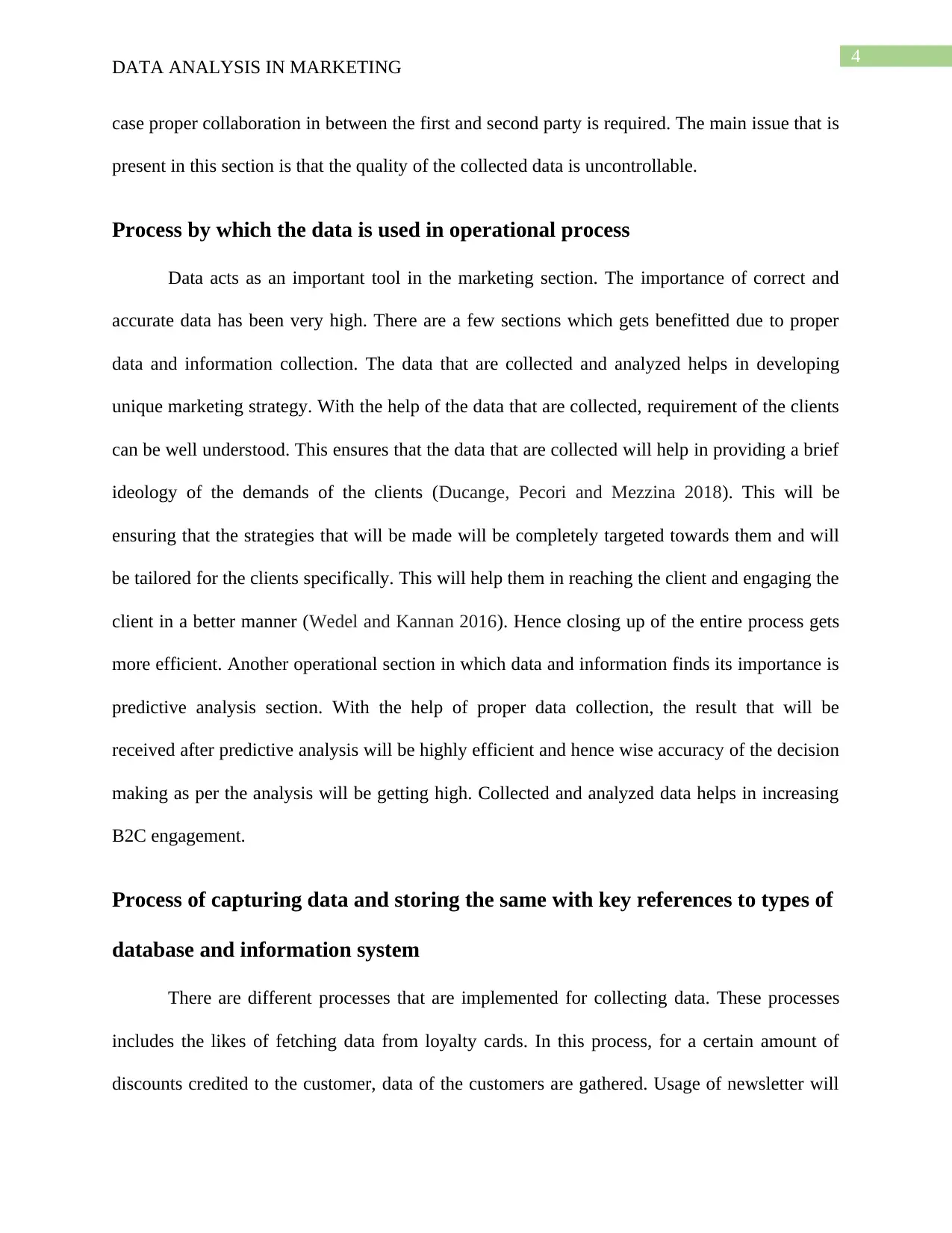
4
DATA ANALYSIS IN MARKETING
case proper collaboration in between the first and second party is required. The main issue that is
present in this section is that the quality of the collected data is uncontrollable.
Process by which the data is used in operational process
Data acts as an important tool in the marketing section. The importance of correct and
accurate data has been very high. There are a few sections which gets benefitted due to proper
data and information collection. The data that are collected and analyzed helps in developing
unique marketing strategy. With the help of the data that are collected, requirement of the clients
can be well understood. This ensures that the data that are collected will help in providing a brief
ideology of the demands of the clients (Ducange, Pecori and Mezzina 2018). This will be
ensuring that the strategies that will be made will be completely targeted towards them and will
be tailored for the clients specifically. This will help them in reaching the client and engaging the
client in a better manner (Wedel and Kannan 2016). Hence closing up of the entire process gets
more efficient. Another operational section in which data and information finds its importance is
predictive analysis section. With the help of proper data collection, the result that will be
received after predictive analysis will be highly efficient and hence wise accuracy of the decision
making as per the analysis will be getting high. Collected and analyzed data helps in increasing
B2C engagement.
Process of capturing data and storing the same with key references to types of
database and information system
There are different processes that are implemented for collecting data. These processes
includes the likes of fetching data from loyalty cards. In this process, for a certain amount of
discounts credited to the customer, data of the customers are gathered. Usage of newsletter will
DATA ANALYSIS IN MARKETING
case proper collaboration in between the first and second party is required. The main issue that is
present in this section is that the quality of the collected data is uncontrollable.
Process by which the data is used in operational process
Data acts as an important tool in the marketing section. The importance of correct and
accurate data has been very high. There are a few sections which gets benefitted due to proper
data and information collection. The data that are collected and analyzed helps in developing
unique marketing strategy. With the help of the data that are collected, requirement of the clients
can be well understood. This ensures that the data that are collected will help in providing a brief
ideology of the demands of the clients (Ducange, Pecori and Mezzina 2018). This will be
ensuring that the strategies that will be made will be completely targeted towards them and will
be tailored for the clients specifically. This will help them in reaching the client and engaging the
client in a better manner (Wedel and Kannan 2016). Hence closing up of the entire process gets
more efficient. Another operational section in which data and information finds its importance is
predictive analysis section. With the help of proper data collection, the result that will be
received after predictive analysis will be highly efficient and hence wise accuracy of the decision
making as per the analysis will be getting high. Collected and analyzed data helps in increasing
B2C engagement.
Process of capturing data and storing the same with key references to types of
database and information system
There are different processes that are implemented for collecting data. These processes
includes the likes of fetching data from loyalty cards. In this process, for a certain amount of
discounts credited to the customer, data of the customers are gathered. Usage of newsletter will
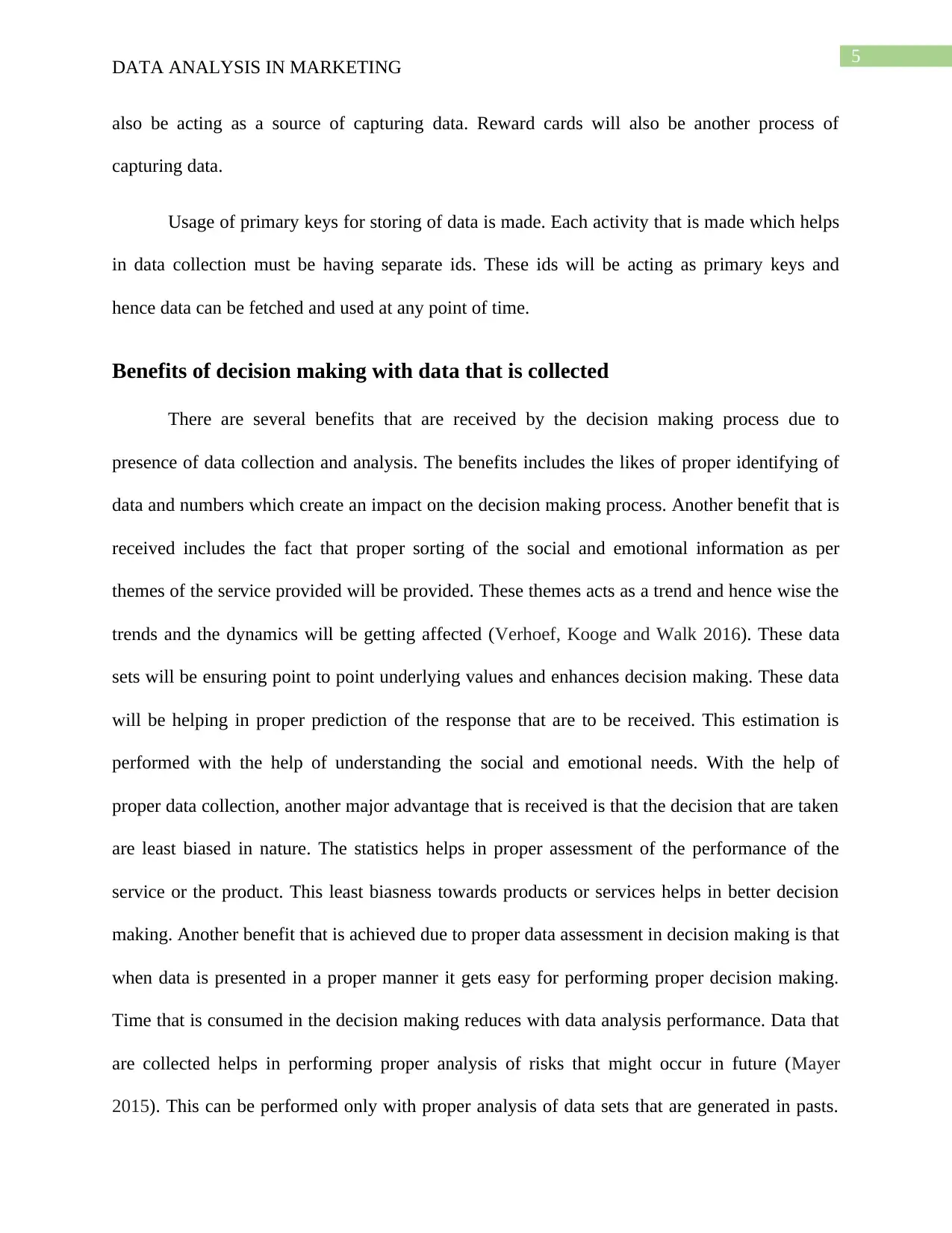
5
DATA ANALYSIS IN MARKETING
also be acting as a source of capturing data. Reward cards will also be another process of
capturing data.
Usage of primary keys for storing of data is made. Each activity that is made which helps
in data collection must be having separate ids. These ids will be acting as primary keys and
hence data can be fetched and used at any point of time.
Benefits of decision making with data that is collected
There are several benefits that are received by the decision making process due to
presence of data collection and analysis. The benefits includes the likes of proper identifying of
data and numbers which create an impact on the decision making process. Another benefit that is
received includes the fact that proper sorting of the social and emotional information as per
themes of the service provided will be provided. These themes acts as a trend and hence wise the
trends and the dynamics will be getting affected (Verhoef, Kooge and Walk 2016). These data
sets will be ensuring point to point underlying values and enhances decision making. These data
will be helping in proper prediction of the response that are to be received. This estimation is
performed with the help of understanding the social and emotional needs. With the help of
proper data collection, another major advantage that is received is that the decision that are taken
are least biased in nature. The statistics helps in proper assessment of the performance of the
service or the product. This least biasness towards products or services helps in better decision
making. Another benefit that is achieved due to proper data assessment in decision making is that
when data is presented in a proper manner it gets easy for performing proper decision making.
Time that is consumed in the decision making reduces with data analysis performance. Data that
are collected helps in performing proper analysis of risks that might occur in future (Mayer
2015). This can be performed only with proper analysis of data sets that are generated in pasts.
DATA ANALYSIS IN MARKETING
also be acting as a source of capturing data. Reward cards will also be another process of
capturing data.
Usage of primary keys for storing of data is made. Each activity that is made which helps
in data collection must be having separate ids. These ids will be acting as primary keys and
hence data can be fetched and used at any point of time.
Benefits of decision making with data that is collected
There are several benefits that are received by the decision making process due to
presence of data collection and analysis. The benefits includes the likes of proper identifying of
data and numbers which create an impact on the decision making process. Another benefit that is
received includes the fact that proper sorting of the social and emotional information as per
themes of the service provided will be provided. These themes acts as a trend and hence wise the
trends and the dynamics will be getting affected (Verhoef, Kooge and Walk 2016). These data
sets will be ensuring point to point underlying values and enhances decision making. These data
will be helping in proper prediction of the response that are to be received. This estimation is
performed with the help of understanding the social and emotional needs. With the help of
proper data collection, another major advantage that is received is that the decision that are taken
are least biased in nature. The statistics helps in proper assessment of the performance of the
service or the product. This least biasness towards products or services helps in better decision
making. Another benefit that is achieved due to proper data assessment in decision making is that
when data is presented in a proper manner it gets easy for performing proper decision making.
Time that is consumed in the decision making reduces with data analysis performance. Data that
are collected helps in performing proper analysis of risks that might occur in future (Mayer
2015). This can be performed only with proper analysis of data sets that are generated in pasts.
⊘ This is a preview!⊘
Do you want full access?
Subscribe today to unlock all pages.

Trusted by 1+ million students worldwide
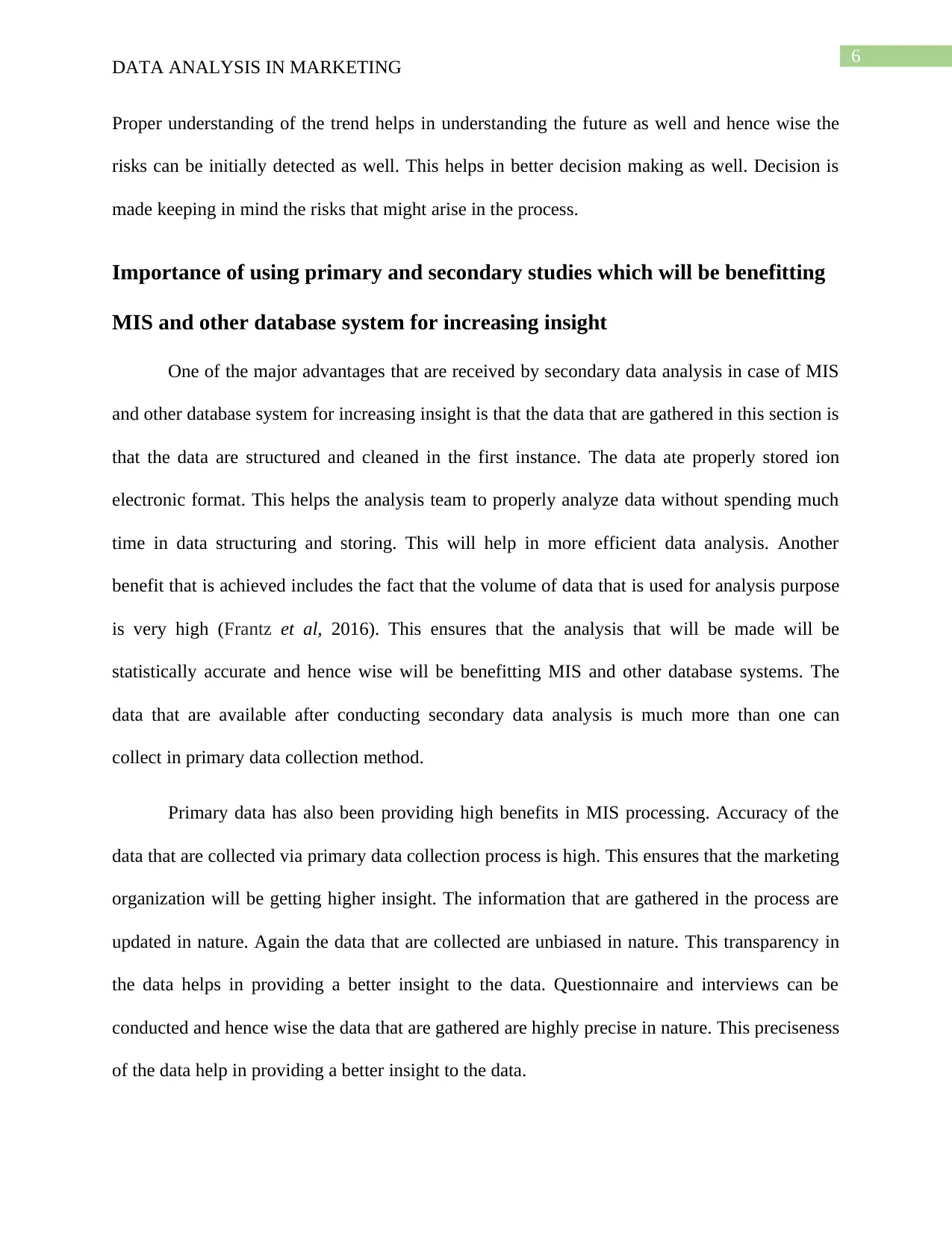
6
DATA ANALYSIS IN MARKETING
Proper understanding of the trend helps in understanding the future as well and hence wise the
risks can be initially detected as well. This helps in better decision making as well. Decision is
made keeping in mind the risks that might arise in the process.
Importance of using primary and secondary studies which will be benefitting
MIS and other database system for increasing insight
One of the major advantages that are received by secondary data analysis in case of MIS
and other database system for increasing insight is that the data that are gathered in this section is
that the data are structured and cleaned in the first instance. The data ate properly stored ion
electronic format. This helps the analysis team to properly analyze data without spending much
time in data structuring and storing. This will help in more efficient data analysis. Another
benefit that is achieved includes the fact that the volume of data that is used for analysis purpose
is very high (Frantz et al, 2016). This ensures that the analysis that will be made will be
statistically accurate and hence wise will be benefitting MIS and other database systems. The
data that are available after conducting secondary data analysis is much more than one can
collect in primary data collection method.
Primary data has also been providing high benefits in MIS processing. Accuracy of the
data that are collected via primary data collection process is high. This ensures that the marketing
organization will be getting higher insight. The information that are gathered in the process are
updated in nature. Again the data that are collected are unbiased in nature. This transparency in
the data helps in providing a better insight to the data. Questionnaire and interviews can be
conducted and hence wise the data that are gathered are highly precise in nature. This preciseness
of the data help in providing a better insight to the data.
DATA ANALYSIS IN MARKETING
Proper understanding of the trend helps in understanding the future as well and hence wise the
risks can be initially detected as well. This helps in better decision making as well. Decision is
made keeping in mind the risks that might arise in the process.
Importance of using primary and secondary studies which will be benefitting
MIS and other database system for increasing insight
One of the major advantages that are received by secondary data analysis in case of MIS
and other database system for increasing insight is that the data that are gathered in this section is
that the data are structured and cleaned in the first instance. The data ate properly stored ion
electronic format. This helps the analysis team to properly analyze data without spending much
time in data structuring and storing. This will help in more efficient data analysis. Another
benefit that is achieved includes the fact that the volume of data that is used for analysis purpose
is very high (Frantz et al, 2016). This ensures that the analysis that will be made will be
statistically accurate and hence wise will be benefitting MIS and other database systems. The
data that are available after conducting secondary data analysis is much more than one can
collect in primary data collection method.
Primary data has also been providing high benefits in MIS processing. Accuracy of the
data that are collected via primary data collection process is high. This ensures that the marketing
organization will be getting higher insight. The information that are gathered in the process are
updated in nature. Again the data that are collected are unbiased in nature. This transparency in
the data helps in providing a better insight to the data. Questionnaire and interviews can be
conducted and hence wise the data that are gathered are highly precise in nature. This preciseness
of the data help in providing a better insight to the data.
Paraphrase This Document
Need a fresh take? Get an instant paraphrase of this document with our AI Paraphraser

7
DATA ANALYSIS IN MARKETING
DATA ANALYSIS IN MARKETING
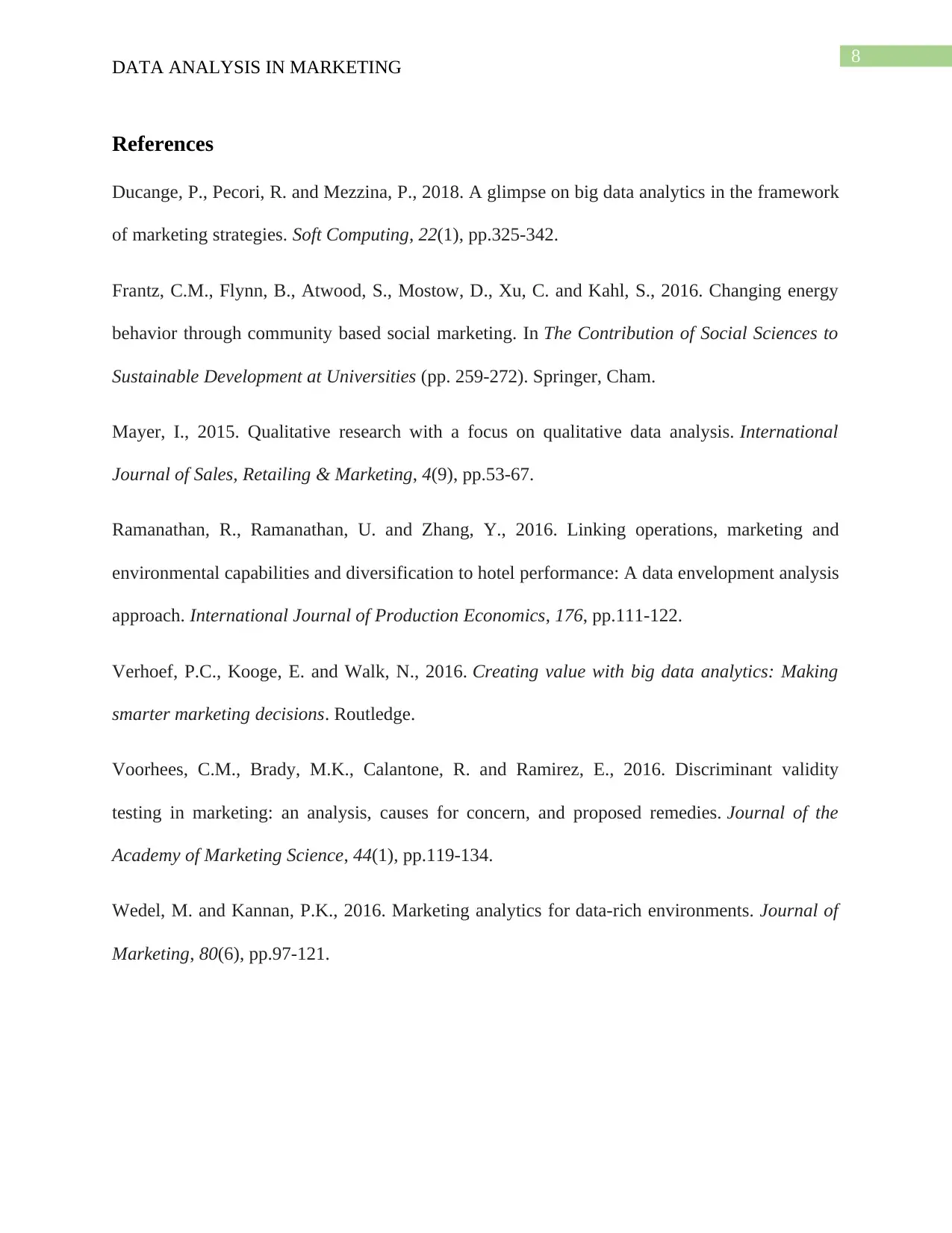
8
DATA ANALYSIS IN MARKETING
References
Ducange, P., Pecori, R. and Mezzina, P., 2018. A glimpse on big data analytics in the framework
of marketing strategies. Soft Computing, 22(1), pp.325-342.
Frantz, C.M., Flynn, B., Atwood, S., Mostow, D., Xu, C. and Kahl, S., 2016. Changing energy
behavior through community based social marketing. In The Contribution of Social Sciences to
Sustainable Development at Universities (pp. 259-272). Springer, Cham.
Mayer, I., 2015. Qualitative research with a focus on qualitative data analysis. International
Journal of Sales, Retailing & Marketing, 4(9), pp.53-67.
Ramanathan, R., Ramanathan, U. and Zhang, Y., 2016. Linking operations, marketing and
environmental capabilities and diversification to hotel performance: A data envelopment analysis
approach. International Journal of Production Economics, 176, pp.111-122.
Verhoef, P.C., Kooge, E. and Walk, N., 2016. Creating value with big data analytics: Making
smarter marketing decisions. Routledge.
Voorhees, C.M., Brady, M.K., Calantone, R. and Ramirez, E., 2016. Discriminant validity
testing in marketing: an analysis, causes for concern, and proposed remedies. Journal of the
Academy of Marketing Science, 44(1), pp.119-134.
Wedel, M. and Kannan, P.K., 2016. Marketing analytics for data-rich environments. Journal of
Marketing, 80(6), pp.97-121.
DATA ANALYSIS IN MARKETING
References
Ducange, P., Pecori, R. and Mezzina, P., 2018. A glimpse on big data analytics in the framework
of marketing strategies. Soft Computing, 22(1), pp.325-342.
Frantz, C.M., Flynn, B., Atwood, S., Mostow, D., Xu, C. and Kahl, S., 2016. Changing energy
behavior through community based social marketing. In The Contribution of Social Sciences to
Sustainable Development at Universities (pp. 259-272). Springer, Cham.
Mayer, I., 2015. Qualitative research with a focus on qualitative data analysis. International
Journal of Sales, Retailing & Marketing, 4(9), pp.53-67.
Ramanathan, R., Ramanathan, U. and Zhang, Y., 2016. Linking operations, marketing and
environmental capabilities and diversification to hotel performance: A data envelopment analysis
approach. International Journal of Production Economics, 176, pp.111-122.
Verhoef, P.C., Kooge, E. and Walk, N., 2016. Creating value with big data analytics: Making
smarter marketing decisions. Routledge.
Voorhees, C.M., Brady, M.K., Calantone, R. and Ramirez, E., 2016. Discriminant validity
testing in marketing: an analysis, causes for concern, and proposed remedies. Journal of the
Academy of Marketing Science, 44(1), pp.119-134.
Wedel, M. and Kannan, P.K., 2016. Marketing analytics for data-rich environments. Journal of
Marketing, 80(6), pp.97-121.
⊘ This is a preview!⊘
Do you want full access?
Subscribe today to unlock all pages.

Trusted by 1+ million students worldwide
1 out of 9
Related Documents
Your All-in-One AI-Powered Toolkit for Academic Success.
+13062052269
info@desklib.com
Available 24*7 on WhatsApp / Email
![[object Object]](/_next/static/media/star-bottom.7253800d.svg)
Unlock your academic potential
Copyright © 2020–2025 A2Z Services. All Rights Reserved. Developed and managed by ZUCOL.





